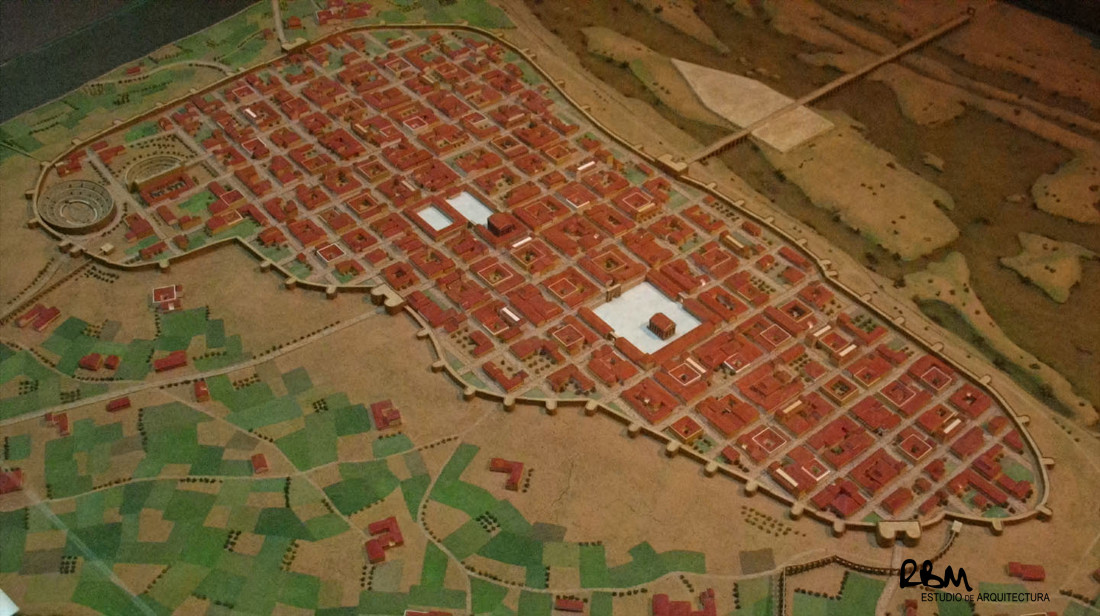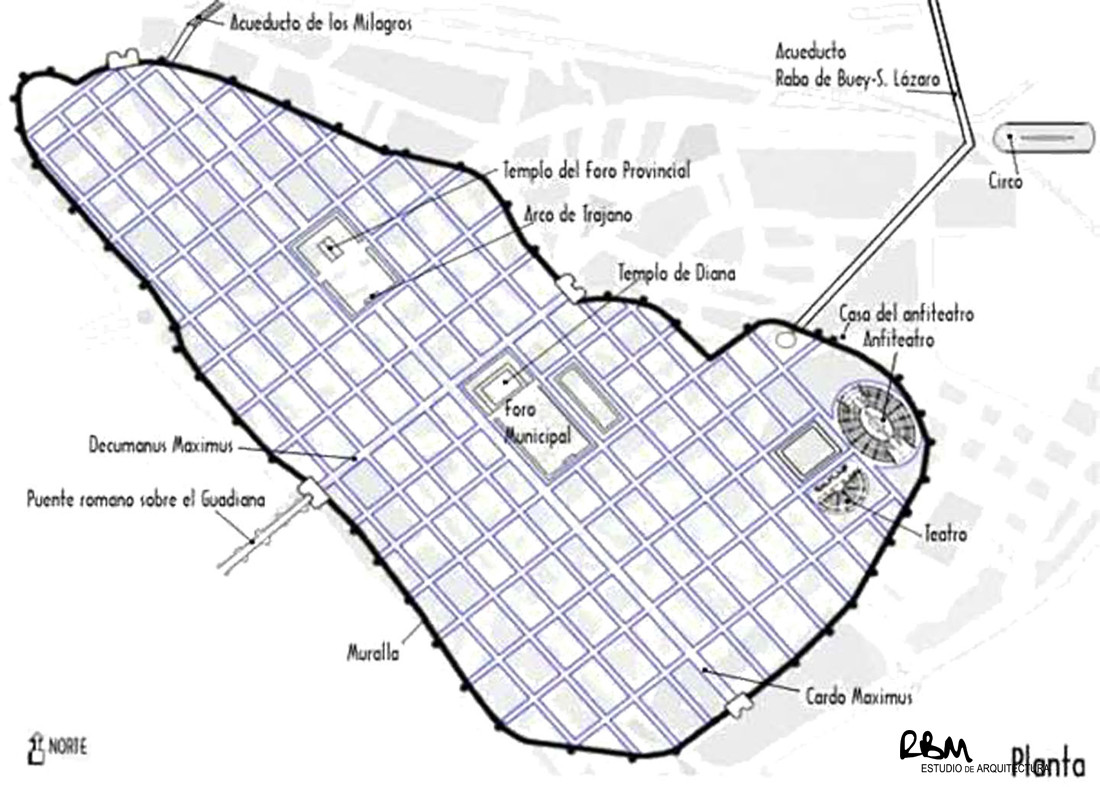Reviewing the history of Mérida, this city was founded by the Roman Empire in the year 25 B.C. by order of the emperor Octavio Augustus as a reward to the retired Roman soldiers who fought in the Cantabrian wars, in addition to a sweetened repudiation to keep these soldiers away from Rome for supporting their rival Marco Antonio in the fourth war of the Roman Republic.
They searched for a unique enclave that imitated the city of Rome with 7 hills, a river and a tributary, where they installed all the equipment that had the imperial capital: theater, amphitheater, forums, temples, aqueducts, wall, bridges, etc.
On this enclave, they traced the two main roads, the decumanus maximum (east-west) and the cardus maximum (north-south) and perpendicularly to them and equidistant, the secondary streets. All this forms the checkerboard or hypodamic layout.
Mérida was capital of the Roman province of Lusitania.
On this checkerboard, the main public facilities were placed.
The Roman amphitheater was a public place where spectacles and games were held, with oval shape and different tiers, occupied according to social and economic rank.
After the passage of time, the lack of use and reuse of materials, it is now a ruin that with subtle reconstructions, we can glimpse its appearance of yesteryear.
Next to the amphitheater, there is the Roman Theater, with semicircular form and stage, where interpretations of dramatic, Greek and Latin works were realized.
This theater has undergone a process of reconstruction and rehabilitation more outstanding than the amphitheater, with new seats, stairs and accesses, in addition to a partial reconstruction of the scenic front.
Since the beginning of the last century, the theater has been used with the International Festival of Classical Theater of Mérida.
As in every Roman city, you can not miss the aqueduct. In this city, there were 4 aqueducts (1 of them had exclusive use of the factories of bricks for the rapid construction of the city) and the best conserved is the Aqueduct of the Milacres.
And the Roman bridge, which in this city exist 2 and one of them with a great length (about 1 km). It was the main communication route between Córdoba and Oporto (from east to west) and the Silver Route (from north to south).
On a religious theme, we must highlight the Temple of Diana, which in fact was dedicated to the imperial cult of Octavio Augusto and is the only Roman religious temple that has survived in Mérida.
The temple has undergone the passage of time and change of use of the different people that have passed through Mérida: Romans, Visigoths, Islamists and Christians.
However, it is due to the use and adaptation of the building that has allowed us to enjoy the building today.
The Roman forum is partially discovered, with its colonnade, statues and entablature. It was the public square for excellence in the Roman Empire and there were the institutions of government, market and religion.
After the fall of the Roman Empire, the Visigoths settled and left their imprint in the city. As best example of this, we have the ruins of the pilgrim hostel and hospital called Xenodochium.
The Museum of Visigothic Art and Culture of Mérida brings together the most important Visigothic art collection of the Iberian peninsula and is located in the former convent of Santa Clara in the historic center.
After the overthrow of the Visigoths at the hands of the Muslims, these settle in much of the Iberian Peninsula.
The Alcazaba of Merida is the oldest Muslim military fortification of the Iberian Peninsula built in the 9th century by Abdemarrán II as a stronghold to control the city.
Inside, there is a small mosque and an underground water reservoir.
The Moreria or Moorish quater of Mérida is the neighborhood that was occupied by the Muslim population after the taking of the city by the Christian troops in the year 1,230.
Currently, part of the ruins are visitable as they are unearthed and under an imposing building elevated above the street level, creating an open-air museum, where Roman, Visigoth and Arab ruins coexist.
The Basilica of St Eulalia is a clear example of transformation over time. Initially, it was conceived as a burial mound of the martyr girl St Eulalia.
This girl was martyred in Roman times by Christian persecution when, after an act of rebellion, she manifested her Christianity before the Romans. The Christians consecrated their martyrdom and later, it was transmitted along the Iberian Peninsula.
Later, the tomb was transformed into paleocristian chapel with cemetery, visigoth basilica and after, the Muslim expulsion, was rebuilt in Romanesque basilica.
At present, the most recent buildings constructed take into account the heritage and the existing ruins.
The most outstanding building is the National Museum of Roman Art, designed by the architect Rafael Moneo, next to the theater and the amphitheater. It is a building that has a correct integration with the environment, the ruins and exposes its ample and valuable collections.
As soon as you enter it, what stands out is the scale of the building, of majestic spatial dimensions where the visitor has the sensation of smallness, which is the same as when you visit the amphitheater or the theater.
Another building is the one of the Councils of the Goberment of Extremadura in the Morería or Moorish quarter, designed by the architect Juan Navarro Baldeweg, building with ruins to the open air and covered previously commented.
A recently built project is the recovery of the surroundings of the Temple of Diana. This Roman temple was surrounded by party walls and lacked access around the temple.
With the intervention of the architect José María Sánchez García, the party walls are hidden behind a continuous building of concrete seen, around the temple as a Roman forum on two floors, allowing to walk around the temple and to have cafes and outdoor terraces, contributing free space to a dense city and with lack of free space in the center.
We also highlight the Mérida´s Auditorium, built on the bank opposite the historic city of the Guadiana River. It is a modern and striking intervention, designed by the Nieto Soberano architectural studio, as a viewpoint towards the historic city and with façades in which the plane of the Roman city of Mérida is continually recreated.
It should be noted that there are many more buildings such as the Roman circus, thermal spas, visitor centers on the ground floor and basements of some buildings, the arch of Trajan, Mitreo house, etc., which are very interesting and must not be forgotten Visit them
Around Merida, there are also many visits, such as the Roman Proserpina dam, the Alange hot springs, etc., which will complete the visit to the city of Mérida.
I hope you enjoyed this guide of architecture and history of Merida.
Best regards.
Raúl Benítez, architect.
+34 647698027 / +34 958192320




















